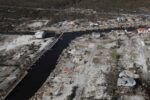Hurricane Laura set to build to Category 4, slam US south coast
Lake Charles (United States) (AFP) – Hurricane Laura is due to strengthen to Category 4 before slamming into the US south coast later Wednesday, forecasters said, as residents of coastal Texas and Louisiana were told to evacuate or shelter.
With maximum sustained winds currently of 115 miles (185 kilometers) per hour, the hurricane could trigger a storm surge raising water levels by several feet and affecting areas as much as 30 miles inland.
The hurricane threatens “potentially catastrophic storm surges, extreme winds and flash flooding” along the Gulf Coast, the National Hurricane Center said. “Laura is a dangerous Category 3 hurricane… and is forecast to continue strengthening into a Category 4 hurricane later today.”
Evacuations have been underway in areas most at risk. Several emergency shelters opened in Texas, with health precautions in place to fight the spread of the COVID-19 outbreak.
“You only have a few hours to prepare and evacuate for Hurricane Laura. Wherever you are by noon is where you’ll have to ride out the storm,” Louisiana governor John Bel Edwards said on Twitter.
Laura also threatens the major oil refining centers of Lake Charles, Louisiana and Beaumont-Port Arthur, Texas, located near the coast.
Texas governor Greg Abbott said that compared to Category 3 Hurricane Harvey, which caused catastrophic flooding and killed 68 people in 2017, “this is going to be more of a wind event.”
“COVID-19 is going to be in Texas throughout the course of the hurricane,” he warned Tuesday, calling on families who can afford it to take refuge in hotels or motels so they “can be isolated from others.”
– Storm inflames COVID risk –
In New Orleans, Mayor LaToya Cantrell also called for health measures to be respected despite the threat of wind, rain and flooding.
The city’s historic French Quarter was emptied of its tourists, while sandbags were piled up in front of the doorways of colonial-style buildings and windows were boarded up with plywood.
“I’m not worried about the water getting in here from the storm, I’m worried about the rain and then the pumps not working and that’s what will cause the flooding,” Robert Dunlap, a business owner, told AFP.
New Orleans remains traumatized from Hurricane Katrina, which made landfall as a Category 3 storm in 2005, flooding 80 percent of the city and killing more than 1,800 people.
Sonya McCuller, who lived through that storm 15 years ago, said anyone who survived Katrina knows they cannot know what to expect.
“One minute you may think that it’s not going to come, the next minute you’re trying to prepare to make sure you don’t get caught in it. It’s crazy, but we’re just going to see what the next one is going to do,” she said.
Laura earlier caused flooding in Haiti and the Dominican Republic, killing at least 25 people.
In Cuba, it caused material damage but no deaths.
In the Gulf of Mexico, more than 100 oil platforms were evacuated as a precautionary measure, stopping about 80 percent of oil production.
The Atlantic storm season, which runs through November, could be one of the busiest ever this year, with the Hurricane Center predicting as many as 25 named storms. Laura is the 12th so far.
Tropical Storm Marco — which also churned through the Gulf of Mexico — was downgraded from a hurricane and dissipated on Tuesday off the coast of Louisiana before reaching land.
Marco’s weakening winds spared the Gulf what would have been twin hurricanes, unprecedented since records began 150 years ago.
Disclaimer: Validity of the above story is for 7 Days from original date of publishing. Source: AFP.


